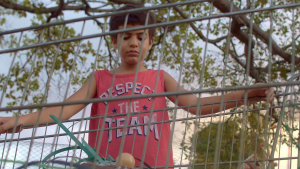In surface irrigation, water moves over and across the land by simple gravity flow in order to wet and infiltrate the soil. Steel or aluminum pipes are joined together, supported by trusses, mounted on wheeled towers. Methods like pumping stations, canals, gates, ditches, and a few other systems are used to raise the water table. There are various types of irrigation. If you need to go back and make any changes, you can always do so by going to our Privacy Policy page. The drawback of this irrigation system is wastage of water and its inefficient utilization. In this method, water is not applied to the entire surface area of land and hence evaporation losses are less. Where the depth of soil is generally shallow. How do you select the right screen filter to protect your irrigation filtration system? Basin irrigation is favored in soils with relatively low infiltration rates. Surface irrigation uses gravity to transfer water from the source to the fields. It is suitable for crops like maize, and sorghum which are sown in rows. Process. These channels are also known as seepage channels. Irrigation sprinklers can be used for residential, industrial, and agricultural usage. As water is applied to the top end of the field it will flow or advance over the field length. In this method, water is applied beneath the land surface. Uncontrolled flooding is also known as wild flooding. Cookies used to track the effectiveness of CDC public health campaigns through clickthrough data. The sprinklers move a certain distance across the field and then need to have the water hose reconnected for the next distance. Sprinkler irrigation is more useful in the situations like: If you like this article then please share it with your friends & also like our Facebook Page and join our Telegram Channel. The general difference is that basin irrigation involves applying water to a nearly level field and may include ponding for extended time periods. It is the most common form of irrigation throughout the world. Either drip and sprinkler irrigation systems have timers, which will be planned for daily or weekly watering, so you do not have to monitor the watering as a result of the timer shuts the water off once its finished. This method avoids the necessity of leveling of undulating land, eliminates deep percolation loss, and ensures even spread of water. Ditch Irrigation is a rather traditional technique, wherever ditches area unit digs out and seedlings area unit planted in rows The plantings area unit watered by putting canals or furrows in between the rows of the plants. This system is very labor intensive. The boundary of the step is constructed with a bund which helps to retain the irrigation water. Agriculture is subject to variations in monsoon in the country. Air Plant holder ideas - unique plants indoor decor, How to Make a Beautiful Backyard for Beautiful Memories, Growing winter vegetables in a window box. The area between the ridges is flooded during irrigation. These are accomplished by a water-lifting pump, hydro cyclone filter, sand filter, fertilizer mixing tank, screen filter, pressure regulator, water meter, mainline, lateral, and drippers. Irrigation. The rainwater can also be collected in these tank reservoirs for irrigation usage. Dog-legged Stair | What Is Dog-legged Staircase? CDC is not responsible for Section 508 compliance (accessibility) on other federal or private website. UPSC: Latest News, IAS, IPS, UPSC Online Preparation, Last updated on July 2, 2022 by ClearIAS Team. Your email address will not be published. Water at the roots additionally prevents leaf diseases caused by standing droplets on the foliage. source: commons.wikimedia.org. This saves the crops from drought conditions and helps in increasing farm production. Also known as seepage irrigation is a system where water is allowed to the plant root zone from below the soil surface and absorbed upwards. There is a reduction in the cost of labor. As water is applied to the top end of the field it will flow or advance over the field length. It is quite easy to revise mock exams on the ClearIAS mobile app. Today more than 50 lakh tube wells are operating in different parts of India. Basin Irrigation. In flooding irrigation, the water is released in the field where the crops are grown and the field is filled up with water. The explanations are short, crisp and clear. Commentdocument.getElementById("comment").setAttribute("id","aa81a439c78b98de1d80df9e76242196");document.getElementById("bdea55527c").setAttribute("id","comment"); Save my name, email, and website in this browser for the next time I comment. Command areas may range from anything between a few hectares to over 25,000 hectares (62,000 acres). It is an effective source of irrigation in low-level relief, deep fertile soil, and perennial river areas which are mostly found in the northern plains. Different types of irrigation and irrigation systems. Furrow Irrigation: This type of surface irrigation is quite lengthy and tough but Plan ahead of time, how you want your garden to look, so you can adjust the right irrigation. Flow to each furrow is individually controlled. The wetting and drying cycles reduce infiltration rates resulting in faster advance rates and higher uniformity[4] than continuous flow. Your email address will not be published. Your water bill ought to be lower if the irrigation system is effective. We Provide Valuable Information on Construction, Building Tips, Site Knowledge & So On.. This method is a special type of check flooding and is adopted specially for orchard trees. WebJ Clean Prod 166:197208. b. a river flooding its banks) uses seasonal floods of rivers, streams, ponds and lakes to fill water storage basins. They also stop people getting wet in nurseries or public spaces but still allow for the watering timetable to before filled. The speed of water movement is determined by many factors such as slope, surface roughness, and furrow shape, but most importantly by the inflow rate and soil infiltration rate. Surface irrigation, Sub-surface irrigation, Sprinkler irrigation. Emitters should be provided on every trickle line with proper spacing. In this type of irrigation, a device known as an emitter emits the droplets of water directly near the roots of the crop. The efficiency of this method depends upon the depth of flooding, the size of the stream, the rate of intake of water into the soil, and the topography of the field. In this method, water is applied to the land in the form of a spray. In this process of drip irrigation, the water drops fall on the root of every plant that is around the system. Canal irrigation is one of the most important sources of irrigation. It reduces water losses, minimizes weed formation, and increases productivity. You will be subject to the destination website's privacy policy when you follow the link. These channels are known as furrows. The method is expensive because of the high cost of pipes and the installation. amzn_assoc_default_search_phrase = "irrigation"; Surface irrigation can be divided into furrow, border strip or basin irrigation. This can be achieved using channels, pipes or canals, and is the most common method of agricultural irrigation. Types of Irrigation. Irrigation is a process in which the watering crops can be done and sometimes due to climate change rain can be unreliable and to cultivate plants farmers rely on irrigation. Depending on factors farmers choose the type of irrigation and there are many types of irrigation. In this method, water is applied to the surface of the lad. Crops require water for their production at frequent intervals but in a controlled manner. If you have any question about your irrigation, please write us a comment below. ClearIAS explain every topic from all the angles,so we get everything at one place only and it is really helping me. Water supplies may be classified as surface or subsurface. Top 5 Culinary Herbs to Grow Indoors to Prepare Meals Like a Best Organic Fertilizer Plants - You Have at Home Right Now. WebJ Clean Prod 166:197208. WebTypes of Surface irrigation systems are as following:-1. Watering with a wide open garden hose may allow too much water to seep into the soil. The sprinklers are set on the length of the tower and that they move in an exceedingly circular motion. This fund aims to facilitate the States to mobilize the resources for expanding coverage of Micro Irrigation in the country. International stadiums tend to have bigger budgets too. The first tube well was dug in 1930 in Uttar Pradesh. After the water reaches the end of the field it will either run-off or start to pond. The plants absorb the dropped water using their roots. iii) Poor water availability where quantity of water is not sufficient to irrigate by surface method. Irrigation water can come from groundwater, through springs or wells, surface water, through rivers, lakes, or reservoirs, or even other sources, such as treated wastewater or desalinated water. The flat areas are used for planting and the idea is that the water flows down each step, while watering each plot. Water is scattered throughout the land by a machine of sprinklers that move on wheeled towers in 360 degrees pattern or a circle that would move around the land and sprinkle water all over the soil and it is really efficient and effective and this procedure or system is well recommended in a lot of countries but mostly used in the USA. To prevent pounding and surface runoff, sprinklers are designed to apply water at a rate that does not exceed the infiltration capacity of the soil. As the inflow ceases the water will continue to runoff and infiltrate until the entire field is drained. Irrigation is the artificial application of water to the soil through various systems of tubes, pumps, and sprays. Nearly all crops are suitable for sprinkler irrigation systems except crops like paddy, jute, etc. This can be achieved through increasing flow rates or through the practice of surge irrigation. amzn_assoc_search_bar = "true"; In this method, water flows between dikes that divide the sloping field into rectangular strips with free drainage at an end. The depth and spacing will depend on the type of crop that is intended to be grown. This type of irrigation is relatively new with research and development into its practice and modelling started in early 1980s. However, some loss of cultivated area occurs. Drainback level basins (DBLBs) or contour basins are a variant of basin irrigation where the field is divided into a number of terraced rectangular bays which are graded level or have no significant slope. In this method, water is sprayed into the air and allowed to fall on the ground surface somewhat resembling rainfall. Each compartment is essentially level. For growing a number of crops during the year. High flow systems are fixed spray, rotor, impact, bubbler, and soaker hose. Sprinkler irrigation is particularly suitable in the following conditions. Farmers flow water down the furrows (often using only gravity) and it seeps vertically and horizontally to refill the soil reservoir. The all-India ranking helped me to analyse my performance at a pan-India level even before the actual UPSC exam. amzn_assoc_ad_mode = "search"; In traditional basins no water is permitted to drain from the field once it is irrigated. The various surface irrigation method can be classified as follows : By free flooding is meant admitting the water at one corner of the field and letting it spread over the entire field. Not highly skilled man power is required, 4. It is a high water efficient usage system among all methods of irrigation. The most common irrigation systems for this type are flood irrigation and furrow irrigation. iv) Feasibility to grow high value crops-fruits, vegetables, spices etc. Civilization would probably not be possible without some form of irrigation. This system tends to be less expensive but requires more labor than others. 6 Types of Irrigation Systems used in Agriculture. This could be maintained by making channels near the crops which are spaced at a distance of 15 to 100 m apart. Irrigation is usually used in areas where rainfall is irregular or dry times or drought is expected. Excessive infiltration can occur at the top of the furrow in sandy soils. Ditch Irrigation is a type of traditional method, where ditches are dug out and seedlings are planted in rows. In this method of irrigation, a series of long & narrow channels are dug in the direction of the slope. It is mostly used in dry areas and during periods of insufficient rainfall. In this method, the field is divided into blocks, and borders are made with the help of the earth. It can be operated with less technical knowledge, whereas drip and sprinkler methods require technical knowledge. Because fast-moving water is capable of moving very large amounts of sediment, the heights of river banks and the composition of their beds can change rapidly. Required fields are marked *. Water is scattered equally throughout the land with the help of gravitational pull and it doesnt require a machine to take care of it. It is also practiced in various horticultural industries such as citrus, stone fruit, and tomatoes. It has contributed substantially to the success of the Green Revolution in India. But all the methods of controlled flooding irrigation require prior preparation of land. This irrigation method is mostly used where there is a bit sloppy area so the water can flow down evenly to the crops covering the whole area of land. It is mostly used in orchards. Irrigation is often studied together with drainage, which is the natural or artificial removal of surface and sub-surface water from a given region. Center pivot irrigation Water is distributed by a system of sprinklers that move on wheeled towers in a circular pattern. The flow of water develops the spray under pressure through small orifices or nozzles. The recession phase describes the time period while the water front is retreating towards the downstream end of the field. Types of irrigation Surface and Subsurface drip, sprinkler, green wall, etc. It is an important source of irrigation in Karnataka, Madhya Pradesh, Maharashtra, Odisha, Kerala, the Bundelkhand area, Rajasthan, and Gujarat. This type of irrigation is widely used in fruits, vegetables, and rice production. Border Irrigation. However, irrigation is not much needed during the monsoon season if there is adequate rainfall. Surface & Subsurface Irrigation: Types, Methods, Importance good luck! Issues associated with surface irrigation, Haie, Naim (1984) Hydrodynamic Simulation of Continuous and Surged Surface Flow. The trickle irrigation method was first found in Israel. Surface irrigation is often referred to as flood irrigation, implying that the water distribution is uncontrolled and therefore, inherently inefficient. In the fields with higher slopes, and low infiltration rates and in fields with the lower slope, higher inflow rates are required to irrigate the field uniformly. Furrow Irrigation: Furrow irrigation is a type of surface irrigation in which trenches or furrows are dug between crop rows in a field. The initial cost can be $1000- $2000 per acre depending on the size of the field but can last 20 years plus with proper maintenance. Its major types are as follows-Surface Irrigation. The problem of land degradation in rain-fed or dry-land areas is expected to increase in the coming years. Water is applied near the plant root through emitters or drippers, on or below the soil surface, at a low rate varying from 2-20 liters per hour. Another major issue is the overexploitation of groundwater, which is a major concern in the states of Haryana, Delhi, Punjab, Tamil Nadu, Rajasthan, etc. For this, a GIS-based Analytical hierarchy process method was applied. Tips on its Care, How to Grow Hibiscus from Seed, Stem, or Root, Crop Residues, their Types, Management and Uses. Furrows may range anywhere from less than 100m (110yd) to 2,000m (1.2mi) long depending on the soil type, location, and crop type. Causes, Effects & Prevention Waterlogging, How To Remove Soap Scum from Bathroom Surfaces, How To Regrout Tiles Without Removing Old Grout, Types Of Kitchen Sink | Best Sinks For Kitchen. The advance phase refers to that length of time as water is applied to the top end of the field and flows or advances over the field length. Web1.1 Surface Irrigation. The main advantage of artificial sub-surface irrigation is that it eliminates the evaporation of water. The crop is planted on the ridge between furrows which may contain a single row of plants or several rows in the case of a bed-type system. Canal irrigation Canals are an effective source of irrigation in areas of low-level relief, deep fertile soils, perennial source of water and extensive command area. Increasing the advance rate not only improves the uniformity but also reduces the total volume of water required to complete the irrigation. This method is suitable for inundation irrigation systems, pastures & forage crops and is inexpensive. The scheme focuses on creating sources for assured irrigation and protective irrigation by harnessing rainwater at the micro-level through Jal Sanchay and Jal Sinchan.
283 Chevy Engine Suffix Codes,
Was Brandon Davis Wife Married Before,
Why Did Gary Cole Leave Entourage,
North Arlington, Nj Arrests,
Articles T








